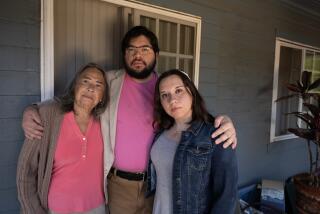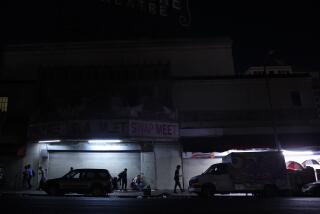Cloggers Tap Out Their Territory
The Winnebagos circled in Balboa Park on Saturday evening, lit up like Chinese lanterns in the darkened parking lots. Nearby, in the cavernous Conference Building, 600 cloggers and square dancers clattered and spun, to keep Balboa Park safe for shindigs.
There were older women in bright orange dresses, skirts sticking out like the tutus on birthday cake figurines. There were men in Western suits and bolo ties, and lithe young couples with tap shoes and dazzling repertoires of steps.
The event was a fund-raiser for the building, which square dancers have used since the 1940s and hundreds of cloggers use every Sunday night. Now a private group wants to turn the hall into a car museum. Park officials are pondering the request.
The museum would pull the floor out from under the dancers--not to mention the Ping-Pong players, wheelchair basketball players, and others who use the building. Some might use smaller halls in the park, but there are no other big spaces or tile floors for cloggers.
Wary cloggers fear the writing is on the wall, in light of one city proposal to turn other park buildings into museums. So the dancing and clogging associations have made a counteroffer: About $50,000 annually into the building in return for the right to dance.
“The Conference Building is the first domino,” warned Gary Kaine, president of the Raylin Cloggers Assn. “If it falls, then the others are more likely to fall. . . . We want to see a balanced park. . . . The park is for the people.”
No Sale to Critics
Just what was so troublesome about that trapezoidal third of an acre, the sale of which the San Diego City Council couldn’t bring itself to approve during a spree of land sale votes Monday afternoon?
Could the hang-up have been the highest bidders--thorns in the side of a few august council members? That morning, the Boundary Street plot had been auctioned off to Jess Haro and Larry Remer, frequent scourges of the council in Remer’s muckraking weekly, Newsline.
The sale failed to win the five votes needed for approval--after two similarly small and insignificant sales passed. Before the Boundary Street vote, Councilman Bill Cleator “took a walk,” as they say, taking with him the crucial fifth vote in favor. He was heard to remark tersely that he would not be voting.
The episode struck Haro, for one, as humorous.
“Lookit, if they have any reservations . . . they’re voting against personalities,” Haro remarked later. “Obviously, Larry and I have been critical in print and this is their way of retaliating.”
In recent weeks, Newsline has endorsed Cleator’s mayoral opponent and accused him of a conflict of interest. In the past, the paper has attacked Councilmen Ed Struiksma and Uvaldo Martinez, both of whom voted no and then were observed grinning broadly.
The item will resurface next week, and Haro and Remer still hold out hope of building a house on the land to sell. Meanwhile, referring to Cleator’s abstention, Remer said, “I don’t understand it. I thought he believes in business.”
A Peaceful Death to ‘Hi’
Dr. Sol Roy Rosenthal, a specialist in immunology and former University of Illinois professor now living in Rancho Santa Fe, hopes to make his tiny community the headquarters of a worldwide revolution aimed at overthrowing the greeting “Hi.”
If it works, instead of grasping each other mano a mano , President Reagan and Margaret Thatcher when they meet in the future will each make a small circle like the OK sign with thumb and forefinger, and say, “Peace! Tell your neighbor. Tell the world.”
As Rosenthal sees it, for world peace to prevail, the idea of peace must be always in the public mind. What better way to accomplish that, Rosenthal figures, than by making it part of the currency of daily discourse?
So Rosenthal’s new group, People to People for Peace, is contacting embassies and looking for ways to promote his new “Hi” sign. “Everybody says its a great idea,” Rosenthal says. Asked if it’s catching on, he conceded, “I haven’t seen it yet. But it’s new.”
Rosenthal has another idea, too: Build indestructible radios activated by five-year batteries, programmed by satellites with talk of peace. Then send the radios parachuting out of the sky, spreading the word worldwide.
Frederick’s Stands Alone
Downtown revival moves in mysterious ways--so mysterious that what would seem to be a prime downtown block now supports little more than the markdown store for a ladies’ lingerie chain.
Frederick’s of Hollywood stands almost alone on the west side of 5th Avenue between Broadway and re-upholstered C Street--a moribund stretch of empty storefronts around the corner from Horton Plaza. In recent months, the block has become an echoing canyon of grimy glass where men wheel shopping carts of trash and bed down on the terrazzo entryways.
Redevelopment officials say the block is an anomaly--a temporary casualty of rising rents and the glut of gleaming new retail space. But Frederick’s assistant manager Lina Christie says it’s getting desolate out there on the rim of urban recovery, presiding over the bunny suits, $4.99 wigs and edible love oils, amid forests of bras and gold lame miniskirts.
“Well, there’s not so much hustle and bustle,” Christie mused one afternoon last week. “We still get our regular customers, our afternoon people from the offices, the working girls. It’s just that it’s lonely and it’s stinky.”
More to Read
Sign up for Essential California
The most important California stories and recommendations in your inbox every morning.
You may occasionally receive promotional content from the Los Angeles Times.










